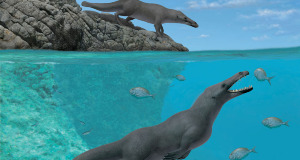
When you think of whales, you probably imagine huge and glorious animals at sea. However, millions of years ago, whales looked more like an ordinary otter at the zoo, just bigger, and with different behavior.
The Peregocetus pacificus, or “traveling whale that reached the Pacific,” had some unique characteristics that made it different from the modern day whale. It had four legs, very long toes, sharp teeth, a snout, canines, premolars, molars, and possibly fur. It was 13 feet long and weighed around 200 pounds, and had a diet of crustaceans and fish. It was capable of swimming as well as walking on land, but it was not very good at the latter. Even though it was hard for it to be on land, it came out of the water on occasions for things like breeding or giving birth. Unlike its weak ability to travel on land, the traveling whale was a strong ocean swimmer. It swam by pushing back its rear legs and floating smoothly, going up and down with its body from the tail to hip, like a dolphin.
Evidence of the traveling whale was found in Peru’s southern coast, by a group of scientists led by Olivier Lambert, a vertebrate paleontologist at the Royal Belgian Institute of Natural Sciences, in 2011. The discovery included well-preserved bones, most likely around 43 million years old. They found the jaws, legs, part of the spine and tail, pelvis, and the fore and hind legs. It was the first time that evidence of this mammal had been found near the Pacific Ocean. Earlier evidence had been found in multiple areas worldwide, but that led scientists to debate another topic: how did the traveling whale swim across the world?
What scientists can tell is that currents probably carried the whales through the oceans. The path most likely taken by the currents started around India. It continued to North Africa, West Africa, South America, and eventually the Pacific Ocean. Since the whales were forced to stay in water longer than usual, they started to live more aquatic lives. They gained the ability to sleep underwater, but lost others like the ability to walk on land. Along their journeys, they left bones behind that scientists are starting to find.
Whales have evolved to be the glorious sea animals we know today. Luckily, some of their ancient bones were preserved well and scientists are now studying them to give us more interesting information about the whales’ ancestry. Although whales are very different today, they are and always have been special in their own way.
[Source:
DogoNews.com
]

